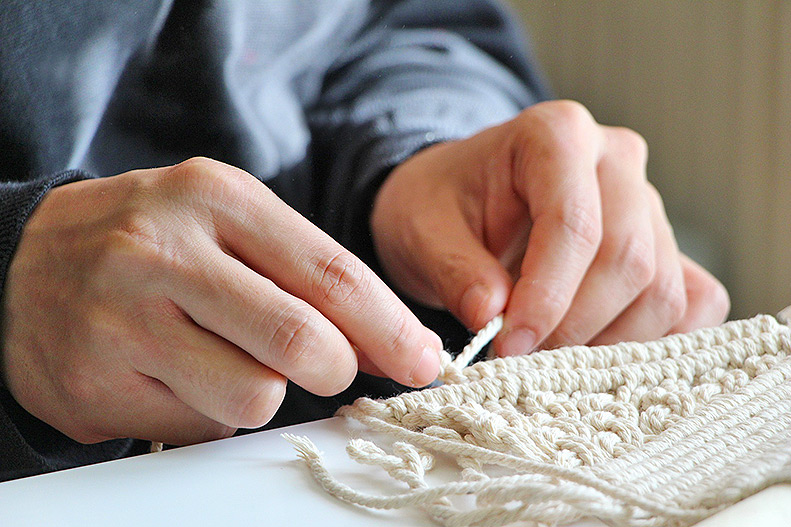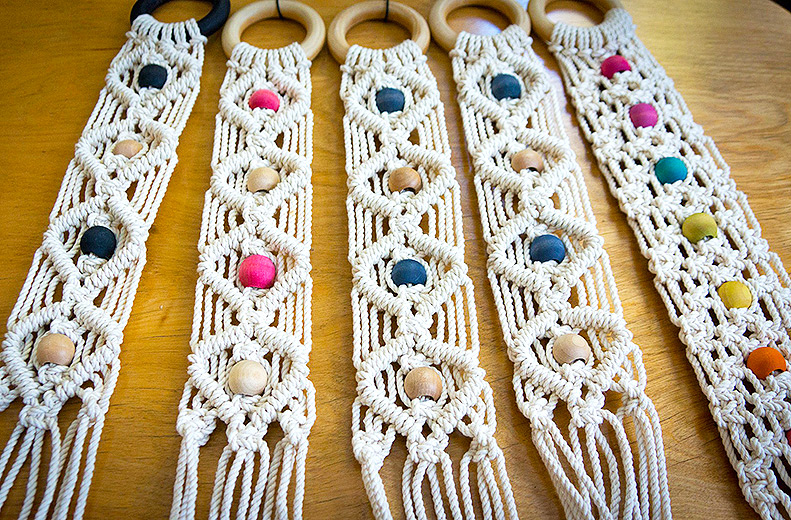
All About Macramé - It's History and Techniques
Macramé is a form of textile produced using knotting cords, often in different colours to create vibrant or neutral shades of wall hangings, plant pot holders, decorative items, and even fashion accessories such as handbags and clothing.
What is Macramé?
A form of textile produced using knotting, macramé products have complex and intricate designs with a variety of uses. The word macramé is derived from the Arabic word miqramah which is translated to mean either “striped towel”, “ornamental fringe” or “embroidered veil”, although it is also believed to have come from the Turkish word makrama meaning “napkin” or “towel”.
Macramé styles consist of various types of knotting, the most common type being the square (or reef knot) and forms of “hitching” or half hitches. Cavandoli macramé is a style that is used to make geometric and free-from patterns much like weaving.
Some of the many items crafted using macramé techniques include leather and fabric belts, friendship bracelets made by school children and teens as well as many decorative items and jewellery sold at funfairs and theme parks.
The History of Macramé
Although the exact date of the first macramé styles is unclear, the earliest records are in the form of Assyrian and Babylonian rock carvings, this evidence shows that macramé style knots adorn the clothing of the people depicted in the carvings.
Despite its Arabian origins, macramé is a technique practised all over the world thanks to 18th and 19th-century sailors. It was only natural that the art would become popular among sailors; the practice of making knots was an essential skill for seamen during the Great Age of Sail and macramé also gave them something to do on long voyages, the finished product could then be sold upon arrival at a port.
Also known as McNamara’s lace to sailors, European merchants in the 1700s and 1800s crafted a wide variety of macramé products including hammocks, bell fringes, and belts, they were taken as far as China and the Americas.

The Muslim conquest of Spain in x brought the craft to the country which then spread fringes and proved to have a practical use in North Africa particularly, they helped keep flies away from camels and horses.
Macramé was also very popular in the Victorian era and everything from tablecloths and bedspreads to curtains and many other items at the time was adorned with it.
In the early 1900s, macramé fell out of popularity only to see a resurgence in the 1970s when wall hangings, clothing accessories, draperies, plant hangings as well as many other macramé items became popular.
Unfortunately, the macramé trend fell into decline in the 1980s when it lay dormant until the millennial; macramé is now back with more styles than ever before. Macramé products can be made using a variety of materials including cords made of cotton twine, linen, jute, leather, or yarn.
There are a few things to consider when choosing the best materials for macramé before starting a project.
Tips for choosing the best macramé cord:
1. Texture – Some fibre materials are rougher than others depending on their composition. Rougher fibre such as jute can look more appealing because of its colour in the finished piece but can be harsh to work with, therefore wearing gloves is a wise choice to protect hands from scratches.
Other materials like cotton, work great in any macramé project and are especially good for practical items like cushion covers and clothing due to their versatility. Cotton rope is soft and easy to work with and knots up perfectly so it could be a material that is used most in macramé.
2. Size – The size of the fibre you use varies on the project, for jewellery, key chains, and other small items, the cord should be smaller than 3mm thick; thinner materials are slightly harder to work with and more time-consuming but the completed piece can be outstanding. Thicker ropes are used for medium projects like wall hangings, bags, plant hangers, and placemats.
The fibre used for these projects is usually between 3mm and 7mm thick. For much larger wall hangings and decoration pieces, the rope can go as thick as 12mm. This size is not commonly used as it is tougher to work with than regular-size rope. Another factor to keep in mind is whether the cord can fit through beads, 3mm cord is perfect for working with beads and other decorations.
3. Twist – There are many names for fibre materials used in macramé depending on how it is made. Braided macramé cord is made by plaiting the fibre together which frays less when worked with. This is good for practical items like bags and outdoor use where sturdy material is required.
Macramé string is produced with twisted fibre which pulls apart easily, making it the perfect material for tassels and decorations that will be combed out. This is also a soft material which is why it is commonly used in macramé. 3 3-strand cord or 3-ply cord is made up of 3 strands of fibre twisted together. It is much stronger than string which is great for most macramé projects and can also be combed nicely to create tassels. The tassels made with a 3-strand cord can be slightly wavy as opposed to the macramé string tassels.
Types of Macramé Design

Wall Hangings: Macrame wall hangings are a popular choice for home decor. They can be made in a variety of sizes and designs and can add texture and interest to any room.
Plant Hangers: Macrame plant hangers are a great way to display your plants and add a bohemian touch to your home. They can be made in various lengths and styles to suit different plants and decor.
Macrame Jewellery: Macrame can be used to make beautiful and unique jewellery pieces such as bracelets, necklaces, and earrings. The intricate knotting and weaving techniques used in macrame can create stunning and intricate designs.
Dream Catchers: Macrame dream catchers are a popular choice for bedroom decor. Dream catchers are believed to filter out bad dreams and promote good ones in some Native American cultures, particularly the Ojibwe people. According to the legend, the dream catcher is hung above the sleeping area and its intricate web-like design catches the bad dreams while allowing the good dreams to pass through and reach the dreamer. The bad dreams get trapped in the web and are destroyed by the first rays of the morning sun. While the belief in dream catchers varies among Native American tribes and individuals, they have become a popular symbol of Native American culture and spirituality. They can be made in a variety of sizes and designs.
Keychains: Macrame keychains are a great way to add a bohemian touch to your keys. They can be made in a variety of colours and designs to suit different tastes.
Hammocks: Macrame hammocks are a beautiful and functional addition to any backyard or outdoor space. They can be made in a variety of sizes and styles to suit different needs.
Bags and Purses: Macrame bags and purses are a unique and stylish accessory. They can be made in a variety of sizes and designs and are perfect for carrying everyday essentials.
Lampshades: Macrame lampshades can add a cosy and warm touch to any room. They can be made in a variety of sizes and designs and can be customized to suit different types of lamps.
Coasters: Macrame coasters are a great way to protect your table while adding a touch of style to your decor. They can be made in a variety of colours and designs to suit different tastes.
Festive Ornaments: Macrame Christmas ornaments are a unique and festive addition to your holiday decor. They can be made in a variety of designs and colours to suit different tastes and styles.










